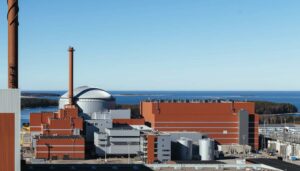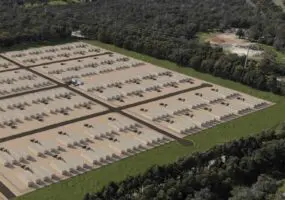The head of the Sun Cable project in the Northern Territory – which may spend $20 billion building the world’s biggest solar farm and battery storage facility, and also the world’s longest sub-sea cable – says the mega-project, if successful, is likely to be the first of many.
The Sun Cable project – backed by billionaires Mike Cannon-Brookes and Andrew Forrest – is currently proposing a massive solar array of 10GW, battery storage facilities of up to 30 gigawatt hours, and a high voltage direct current sub-sea cable of 3,750kms – all the way to potential customers in Singapore. Each component will be the biggest of its type in the world, by some margin.
Last week, Sun Cable announced development approval for a big battery of up to 100MW/200MWh in Darwin, to displace costly gas generators that run as back-up to the existing gas supply that dominates the local grid, and to also facilitate the installation of more rooftop and grid scale solar.
That Darwin battery, at Middle Arm, is designed as a standalone project, but it will likely get absorbed into the larger Sun Cable project if the design, engineering and economics stack up in the detailed modelling that is currently being undertaken.
And in an interview with RenewEconomy’s Energy Insiders podcast, CEO David Griffin says if the numbers do add up for the Sun Cable project – along with a million other different inputs – the huge project is likely to be the first of many.
“There is no way in hell I am doing this once,” Griffin told the Energy Insiders podcast.
“It is only the first of the projects. We are actually developing a long term team capability.”
“Ultimately, we envisage a network that expands, that takes advantages of where the best renewable energy resources are, be it solar and wind in Australia, wind in New Zealand, or solar and wind in India, and we are seeing that … the potential for load growth in the areas in between is enormous.”
“Indonesia will be the fourth largest economy in the world in the 2020s. We seem to miss that in Australia – the enormity of our northern neighbours. We are absolutely developing long term plans to serve those ever-growing loads north of Australia and doing that by exploiting the renewable energy resources wherever they located, and the HVDC technology.”
Griffin says that means the consortium is not just talking tens of gigawatts, but hundreds of gigawatts of potential capacity.
“If you wanted to replicate the LNG industry from a hydrogen perspective, you are talking several hundred gigawatts of generation capacity. We have got the land to do that.”
The prospect of more such mega-projects in the pipeline comes amid an intense debate in Australia – and the rest of the world – about the shape and purpose of Covid-19 recovery plans, with the EU and others focusing on a “green” recovery, putting renewables and climate action at the heart of initiatives, and Australia’s federal government focusing on a “gas-led” recovery.
But many advocates are pointing to the potential of renewable export projects, and “green manufacturing”, using wind and solar to lower electricity prices and re-boot Australia’s manufacturing sector. ARENA boss Darren Miller has talked of Australia reaching “700 per cent” renewables, but his agency may now be forced to invest in gas or carbon capture projects if it receives any new funding.
Sun Cable is one of a number of proposed “mega-projects” that are looking at the potential renewable export market, and to support increased manufacturing and industrial demand in Australia itself.
Most projects, such as the Pilbara-based 15GW Asian Renewable Energy Hub plan backed by Vestas, Macquarie Group and CWP, and the Siemen’s backed 5GW project in the Mid-West, are focused on hydrogen exports, although the Pilbara-based project did once consider a cable to Indonesia.
Sun Cable, as its name suggests, is focused only on cables. Griffin says the company may provide the electricity for others considering a hydrogen opportunity, but hydrogen itself, and electrolysers, are not in its business plan.
Instead, it is focused on solar – using the easily deployable “Maverick” system developed by Australian-based 5B, and big batteries.
Griffin says the battery technology has not yet been chosen, but it is fair to assume that given the huge battery component that would accompany the solar deployment – in the tens of gigawatt hours – will be installed in a few years to come, and the exact specifications of the technology to be deployed are not yet known.
He notes that sub-sea cable technology has jumped ahead, thanks most recently to the huge growth in offshore-wind farm installations. He compares the difference between the Sun Cable’s proposed technology, and the sometimes problematic link between Tasmania and the Australian mainland, as like that of a Tesla and a Morris Minor. They are both cars, but that’s about where the similarity ends.
The Sun Cable project will obviously depend on gaining customers in Singapore, and also in Australia. Griffin reports interest from customers looking for 100 per cent renewable energy, such as data centres, and it’s inevitable the project will be built in stages. The first Middle Arm battery, followed by a first state of solar and more storage to supply local demand, and then the remainder as the sub-sea cable is completed.
Griffin talks of the enormous complexity of the project inputs – too much for a human brain, he says, hence the reliance on AI technology for the modelling. “I doubt that there is another company in the world that has the system dynamics that we have put together. It looks very compelling. We are very confident about the prospects for the project.”
RenewEconomy and its sister sites One Step Off The Grid and The Driven will continue to publish throughout the Covid-19 crisis, posting good news about technology and project development, and holding government, regulators and business to account. But as the conference market evaporates, and some advertisers pull in their budgets, readers can help by making a voluntary donation here to help ensure we can continue to offer the service free of charge and to as wide an audience as possible. Thank you for your support.










